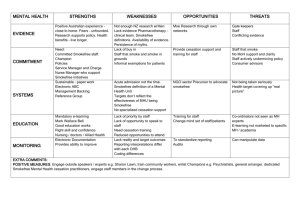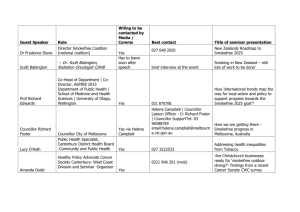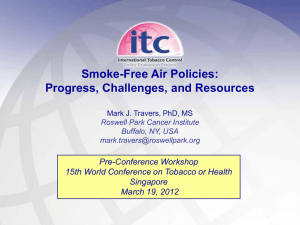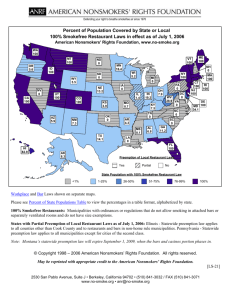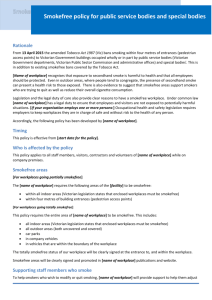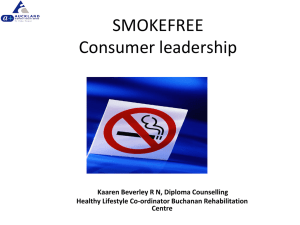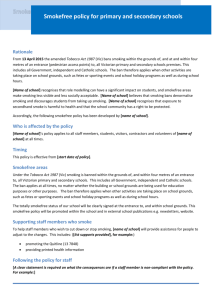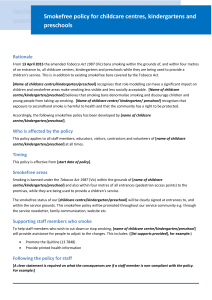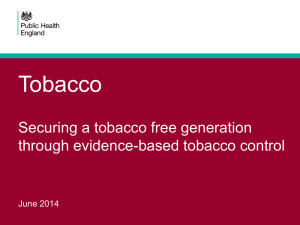to the presentation (Powerpoint or viewer needed)
advertisement
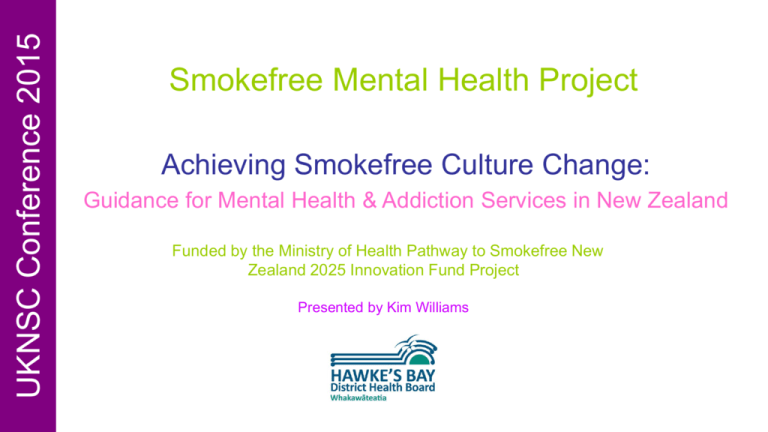
UKNSC Conference 2015 Smokefree Mental Health Project Achieving Smokefree Culture Change: Guidance for Mental Health & Addiction Services in New Zealand Funded by the Ministry of Health Pathway to Smokefree New Zealand 2025 Innovation Fund Project Presented by Kim Williams UKNSC Conference 2015 Aspirational Goal - 95% Smokefree by 2025 $20 million allocated for the Pathway to NZ 2025 Innovation Fund To invest in the design, development, promotion & delivery of innovative efforts to reduce the harm & wider costs of smoking Purpose – to make meaningful progress toward NZ’s aspirational goal to be 95% smokefree by 2025 Smokefree Centre for Excellence – Hawke’s Bay District Health Board Why are we doing it? What we knew… Historically strong culture of acceptance and encouragement of tobacco use across the MH sector (Hitsman et al, 2013). Smoking prevalence among MHS users is more than twice that of the general population at 32 – 56% (Tobias et.al., 2008; Lawrence, Mitrou and Zubrick, 2009). People with MH issues constitute 16% of the NZ population yet they purchase around 30% of the tobacco products sold in NZ (Tobias, 2008). Smoking rates among nurses working in MH settings are much higher than areas of nursing care – 30% of female & 26% of male MH nurses smoke (Edwards et.al., 2008) – healthcare workers who smoke are less likely to provide stop-smoking advice (Myers et.al., 2012) In NZ, “Permissive smoking cultures” evolve in the absence of smokefree role-modelling and visible smokefree leadership (Glover et al., 2013, p.3-4). This is an equity of care issue Who participated… Stakeholder Engagement 6 DHBs gave consent for staff to participate Hawke’s Bay; Gisborne; Taranaki; Counties Manukau; Dunedin; Invercargill 19 NGOs gave consent for their staff to participate DHB & NGO settings: Inpatient wards including secure units & Forensic; Acute Intervention Teams, Community MH&A Teams; Day Activity Programmes; Residential respite; Pharmacy; Advocacy services psychiatrists, psychologists, psychotherapists, GP Liaison, RNs, Com MH RNs, SCs, CSW, CNM, CSM, Portfolio Managers, Managers, Team Leaders, CEO, Clinical Nurse Directors, Quality & Risk, Social Workers, Counselors, OTs, Consumer Advisors, Cultural Advisors, Family Advisors, Youth Advisors Where do MH&ASs stand now? Stakeholder engagement feedback Current challenges: perceptions & practices “Smoking goes hand in hand with mental health illness” (all roles) PWMHI “smoking with staff is a rapport building time…a chance to open up” (Community MH Team RN) “…consultants allocate smoking leave” - literally – noted on whiteboard (acute service manager) “smoking regulates psychotic thinking” (psychiatrist) MH workforce staff are making valued judgements about whether PWMHI want/need SF support (NGO Workplace Lead) “…someone I know was admitted to the inpatient service Smokefree but came out a smoker…” individual comments… Current MH&AS smokefree status Acknowledging smokefree progress much smokefree progress has been made within the Mental Health & Addiction sector some staff & some services are demonstrating stronger Smokefree commitment in general, staff increasingly view ABC as core practice more staff are becoming Smokefree as a result of their organisation’s Smokefree commitment we start this smokefree culture change programme further along the continuum of change than first anticipated we have built on many of the embedded processes & new initiatives underway The key was to develop & implement changes that create consistency for MH&A service users & sustainable best practice Smokefree culture change approach Step 1. Endorse Smokefree Best Practice Principles Principle 1 All settings will have mandated smokefree environment policies, clearly outlining the organisation’s smokefree expectations for service users, staff, whanau and visitors Principle 2 All staff (including those in management & leadership roles) will be mandated to receive & attend regular, smokefree training that is both generic & tailored for the MH&AS context; attendance will be monitored Principle 3 All service users’ tobacco use is routinely assessed as part of their full mental health & wellbeing assessment Principle 4 All service users are provided a shared smokefree support plan*defined as documented smokefree intervention that demonstrates how the staff member has supported the service user to manage nicotine withdrawal in smokefree settings and/or long term support to become smokefree & communicated this plan to the service user’s support network and stop smoking service provider in the case of a stop smoking attempt Principle 5 All staff will role-model smokefree behaviour at all times & the organisation will have a range of measures in place to support compliance Principle 6 All services will demonstrate how they support their staff to become smokefree Step 2. Demonstrate visible smokefree leadership The role of DHB MH&AS Management Work with planning & funding to incorporate this smokefree culture change approach within annual plans Consult with consumer leadership roles & peer support roles to inform strategic MH&AS planning The role of Team Leaders Complete the Smokefree Best Practice Checklist Address gaps in service – put systems in place to support this (see checklist) Enlist a smokefree representative for your service Invite all DHB & NGO MH&AS providers to form a Working Group; to coordinate the delivery of smokefree support to all service users – you could develop a TOR Attend the Working Group or delegate a representative Adopt the 6 Smokefree Best Practice Principles into everyday practice Support & motivate each service to adopt & embed the 6 Smokefree principles & Guidelines into best practice Complete Smokefree Training tailored for the MH&AS workforce first Support & motivate each service to complete the Smokefree Best Practice checklist to identify & address service gaps Support & motivate your staff to complete the training including regular refresher training; monitor staff compliance & attendance Mandate all DHB staff to complete Smokefree Training tailored for the MH&AS workforce including management; all Team Leaders should complete it first Set an expectation (within smokefree policy) that all NGOs contracted to the DHB do the same & offer access to the training Document SFMC interventions within referral/clinical pathways & create monitoring systems Hold training sessions to support your staff to use the SFMC interventions in everyday practice Have regular SFMCs with staff who are not smokefree What does smokefree role-modelling look like? What does undermining behaviour look like? All staff understand that providing a smokefree environment policy sends a message that stopping smoking is important; they feel empowered to actively offer smokefree support (Principle 1) When staff, patient & visitor breaching of smokefree environments go unaddressed; staff feel detached from their role in promoting smokefree lifestyles for service users & their own workforce Smokefree Training is mandatory for all staff (Principle 2) Smokefree Training is optional; some staff perceive smokefree training is less important because it’s not mandatory; mixed smokefree messaging continues Tobacco use is assessed as part of all MH&AS well-being assessments (Principle 3) Tobacco use is not addressed because it’s perceived as less of a health risk than other substance use and/or their MH &/or addiction Smokefree support is a component of all MH&AS recovery plans when a person is not smokefree & the smokefree journey is shared across support networks (Principle 4) Smokefree support is not addressed in recovery plans because the relationship between tobacco use & MH&A is not understood All staff believe that they have a duty of care to role model smokefree behaviour during work hours (Principle 5) All staff take every opportunity to have SFMCs with all service users who are not smokefree as part of routine best practice (Principle 4) All staff are provided adapted SFMCs & supported to manage nicotine withdrawal (Principle 6) Staff smoke with service users Staff perceive that accompanying service users on smoke breaks is an opportunity for rapport building & assessment of MH status Medical staff on inpatient wards overtly allocate smoke breaks & staff accompany service users for safety reasons Staff return from breaks smelling of tobacco smoke & visibly handling tobacco paraphernalia; staff who smoke are less likely to offer smokefree support to service users Step 3. Design & implement Smokefree systems & processes: Smokefree Best Practice Checklist for MH&AS managers Principle 1: Principle 2: Principle 3: Does your service have a smokefree environmental policy? Yes □ No □ Does your service require all staff who undertake mental health & wellbeing assessments to assess service user tobacco use as part of this assessment? Yes □ No □ If yes, is this your own service’s policy e.g. a DHB contractual requirement? Yes □ No □ Is it mandatory within your service that all clinical and non-clinical staff (including those in management and leadership roles) attend smokefree training aimed at addressing your staffs’ understanding of what smokefree commitment is and how it is demonstrated in best practice? Yes □ No □ Principle 5: Do you as a Manager/Team Leader complete this training? Yes □ No □ If yes, is this an overarching organisational (DHB) policy? Yes □ No □ As a service manager/team leader do you follow specific procedures aimed at supporting staff & service user compliance with your service’s Smokefree policy expectations (e.g. not smoking within your service’s buildings & grounds)? Yes □ No □ Do you as a manager/team leader and all your staff complete the Ministry of Health’s ‘ABC’ online training for health professionals? Yes □ No □ Do you as a Manager/Team Leader monitor your staffs’ completion of this training? Yes □ No □ Are there consistent consequences for staff and/or service user non-compliance of your service’s Smokefree policy expectations? Yes □ No □ Do you as a manager/team leader monitor your staff’s completion of this training? Yes □ No □ Do any of your staff accompany service users when they (service users) are smoking – either on or off site? Yes □ No □ Principle 4: Do any of your staff smoke with service users, whether on/off site during working hours? Yes □ No □ Does your service require all staff to provide a smokefree support plan* for all service users identified as currently smoking tobacco? Yes □ No □ Do any of your medical staff allocate leave breaks for the purpose of allowing service users to smoke either on or off site? Yes □ No □ Does your service require staff to record this Smokefree intervention in service user files? Yes □ No □ Is this assessment of Smokefree status recorded in service user files? Yes □ No □ If service users are currently smoking, are they always encouraged & offered nicotine replacement therapy to manage short term abstinence e.g. during inpatient admissions & when attending day activity programmes? Yes □ No □ Principle 6: Are your staff who smoke, regularly encouraged and/or offered the opportunity to manage short term abstinence during work hours? Yes □ No □ During the recruitment process, does your organisation have the capacity to screen potential staff for tobacco use? Yes □ No □ Does your organisation assess/monitor the smokefree status of all current staff? Yes □ No □ Do you in your capacity as manager/team leader regularly* offer Smokefree support to staff identified as currently smoking? * defined as at least 3 monthly Yes □ No □ Step 4. Tailored Smokefree education delivered to all staff Module 1 is designed for ALL staff working within a MH&AS – from staff whose primary work involves face-to-face contact with service users, to administration staff & management whose primary roles are often behind the scenes, though none-the-less important. Modules are supported by role-play DVDs Module 2 is designed for staff who have faceto-face contact with service users and are therefore best placed to deliver SFMCs to service users. Step 5. How to have Smokefree Motivational Conversations 1. Set the agenda for the Smokefree Conversation – use open ended questions to get things started, How do you feel about your smoking? • How does your smoking impact on your mental health? • How do you feel about your smoking during work hours? (to staff ) • How has the new smokefree training made you feel about your own smoking? (to staff ) 1.1 No need to conduct a formal nicotine assessment here: The aim is to engage with your client/staff ; develop rapport; stay client/staff - focussed; try to use more open questions than closed questions 2. Ask about any positive aspects of smoking – this is often an engaging approach provided you are genuinely interested; e.g. you could say… • What do you like about smoking? or • How do you think smoking supports your mental health? 3. Ask about the negative aspects of smoking: • What are some aspects you are not so happy about? Or • What are some of the things you would not miss? SUMMARISE: Provide feedback in the form of a summary reflection using the person’s own words SUMMARISE: Provide feedback in the form of a summary reflection using the person’s own words Step 5. Continued 4. Offer support to stop-smoking; e.g. you could say… • I would like to talk to you about how you could become smokefree, for example…And/or • I could help you manage your tobacco withdrawal symptoms when you are unable to smoke Note: even if someone is not ready to stop-smoking long term, NRT can be used to relieve tobacco withdrawal symptoms in the short term e.g. in smokefree settings. 4.1 Then offer your view; e.g. you could say… Many people who smoke feel like they are stuck & put off trying to stop because they are not sure how to, or are worried that stopping might have some negative impacts on their mental health… Some staff feel funny about offering stop-smoking advice to service users because they smoke themselves... (to staff ) But it’s important that we demonstrate organisation wide smokefree commitment – this means we’re here to support staff too (to staff ) Ask your client what they think of your advice Step 5. Continued Then provide clear advice tailored to their situation. Here are some examples of what you could say… • Stopping smoking is the best thing you could do for your physical health & your mental health And • Getting behaviour support from a stop-smoking service combined with using stop-smoking medication is the best way to stop And/or • Support from peers with lived experience of mental distress & giving up smoking maybe helpful • Even if you are not ready to stop-smoking, NRT can relieve short-term tobacco withdrawal in situations when you cannot smoke and this might lead to a longer smokefree attempt (e.g. inpatient settings) And/or • Did you know that some medications are affected by tobacco smoke? • Free NRT is available to manage your tobacco withdrawal during work hours (to staff – if available) • Being smokefree during work hours could lead to being smokefree in the long term (to staff ) Note: With practice, all staff should have the skills to engage service users in smokefree conversations up to this point… Then ask for a decision… After our discussion are you more clear about what you would like to do? Step 5. Continued 5. If a referral to a stop-smoking service is accepted… • Discuss stop-smoking service provider options • Complete a referral to their chosen provider And/or • Complete a Quitcard (if you are a registered Quitcard provider) and they have chosen to manage short term tobacco withdrawal symptoms with NRT – see above • Explain that it is important to share their smokefree journey with their whole support network to make sure they get all the support they need to successfully stop-smoking OR 6. If no decision is made… • Empathise with & reflect that making a decision can be difficult • Ask if there is something else that would help them make a decision or • Ask if they would like a call from a stop smoking service to explain what they do & reiterate that they would not be committing themselves OR 7. Completing the Smokefree Motivational Conversation intervention Thank the person for the opportunity to talk about their smoking OR Enter this smokefree intervention into service user health system fi les 8. Follow-up If a referral to a stop-smoking service was completed… • Set a follow-up contact date for one week’s time to check the referral progress • Complete a follow-up smokefree intervention within that timeframe (see page 8) If a referral to a stop-smoking service was declined you could say… • I understand that you are not ready to accept support right now but our service thinks this is very important so… > a health professional will offer you support again in 12 weeks’ time DATE* > I will offer you support again at future 1.1s (to staff) 6. If their decision is to continue to smoke you could say… • If you change your mind & want to talk more about stopping smoking let me or your other support staff know or • I understand that you don’t want to stop right now but remember it’s never too late to try or • You might need some more time to think about it – I’ll ask you about your plans > … the next time we meet or > …at your next 1.1 (to staff ) Ideally this *date becomes a mandatory Smokefree 3 month alert on service user files Step 5. Follow up support: Reviewing Smokefree Progress If a referral was made to a stop-smoking service… • Establish whether contact from (name of stop-smoking service) has been made • If yes, ask “how did you get on with the behaviour support & the stop smoking medication this week? And • Ask “what affect has stopping smoking had on your mental health and your health in general?” SUMMARISE: Provide feedback in the form of a summary reflection using the person’s own words • Consider whether mental health-specific advice to the stop-smoking service is required • If yes, ask permission to discuss any mental health medications with their prescriber and/or stop-smoking service OR If the stop-smoking service did not make contact you could… Establish the reason & offer to help the person make contact OR If a referral to a stop-smoking service was NOT accepted or if they were feeling unsure you could: • Empathise & reflect that it can be difficult to make a decision to be smokefree • Remind them that they are much more likely to stop-smoking with a combination of behaviour support & stopsmoking medication • Make another offer to refer them, or for the service to explain what they do AND If Nicotine Replacement Therapy was supplied… • Ask how the chosen NRT products worked to relieve tobacco withdrawal symptoms in situations where they could not smoke • Explore other medication options if NRT has either motivated them to make a quit attempt or if NRT has not worked well for the person AND Continue to liaise with the person’s medication prescriber & stop smoking service as appropriate Guidance document pages 1 - 4 Guidance document pages 5 - 8 UKNSC Conference 2015 References & Contact Details Colton, C. and Manderscheid, R. (2006). Congruencies in increased mortality rates, years of potential life lost, and causes of death among public mental health clients in eight states. Preventing Chronic Illness, 3 1-14. Edwards, R., Bowler, T., Atkinson, J., and Wilson, N. (2008). Low and declining cigarette smoking rates among doctors and nurses: 2006 New Zealand Census data. New Zealand Medical Journal 121 (1284): 43-51. Lawrence, D., Mitrou, F and Zubrick, S.R. (2009). Smoking and mental illness: results from population surveys in Australia and the United States. BMC Public Health 9:285. Ministry of Health. (2014). The New Zealand Guidelines for Helping People to Stop Smoking. Wellington: Ministry of Health. Hawke’s Bay District Health Board (2015). National Mental Health Services Smokefree Guidelines Development: Shifting the Culture. Hastings. Nordin, A.S.A., Sellman, J.D., and Adamson, S.J. (2015). The Role of Psychiatrists in Tobacco Dependence Treatment. ASEAN Journal of Psychiatry, Vol. 16 (1). January – June. Olivier, D., Dan, I., and Fraser, R. (2007). Tobacco smoking within psychiatric inpatient settings: a biopsychosocial perspective. Australian and New Zealand Journal of Psychiatry 2007; 41:572-580. Prochaska, J.J. (2013). Failure to treat tobacco use in mental health and addiction settings: A form of harm reduction? Drug & Alcohol Dependence, Vol 110, Issue 3, 177-182. Siru, R., Hulse, G.K., Tait, R.J. (2009). Assessing motivation to quit smoking in people with mental illness: a review. Addiction. 104, 719-733. Kim Williams Smokefree Mental Health Project Manager Hawke’s Bay District Health Board, New Zealand Phone: 06 8788109 Cell: 0277654485 Email: kim.williams@hbdhb.govt.nz
